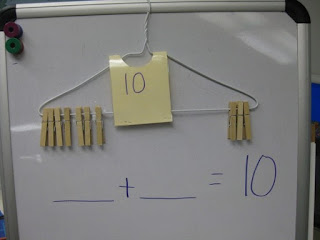Traditional countdown game that most children will have seen on TV. Can be differentiated at different levels. Helps with work on addition, subtraction, multiplication and division.
Maths Teaching Ideas
Tuesday, 3 November 2015
Countdown
Labels:
Addition,
Division,
KS1,
KS2,
Multiplications,
Subtraction
Number bonds to 10
Using coat hanger with pegs on to represent the number bonds to 10, can move them across to see physically
Can then ask what the written calculation this would show
Can then ask what the written calculation this would show
e.g. 7 + 3 = 10
10 - 7 = 3
10 - 3 = 7
Magic V's
- Place the numbers 1-5 in the circles so that each arm adds to the same value
There are 3 unique combinations but by rearranging the numbers there are 24 combinations.
Has to be an odd number at the bottom - get class to think why this is - proof and explanations
Can move on with different numbers etc.
Darts
- Traditional game of Darts can be used to help pupils with addition, subtraction and multiplication
What is my number?
____ ____ ____ ____
> Hundreds digit is double the units
> Tens digit is half of the thousands digit
> Tens digit is 3x smaller than the hundreds digit
> Hundreds digit is double the units
> Tens digit is half of the thousands digit
> Tens digit is 3x smaller than the hundreds digit
Naughty or Nice Game
Roll the die and chose whether want to put that number in your own or somebody else's hundred, tens or unit column to make either the biggest or the smallest number.
Swap a Block! Game
- 2 players, dienes apparatus, a die
1. One player rolls a die and takes that number of units out of the box. The next player does the same. Whenever they can, the players should swap 10 units for a ten or 10 tens for a hundred. The first to 200 wins.
OR
2. Each player starts with 200. As they roll the die they have to remove that number of units from their 200. The first to 0 wins.
1. One player rolls a die and takes that number of units out of the box. The next player does the same. Whenever they can, the players should swap 10 units for a ten or 10 tens for a hundred. The first to 200 wins.
OR
2. Each player starts with 200. As they roll the die they have to remove that number of units from their 200. The first to 0 wins.
Subscribe to:
Comments (Atom)









